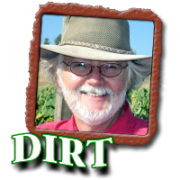Gardening Tips
She was falling in love with this oak. I was not going to discourage her.
I’m from the mid-west and I cannot fathom why most folks in Southern California are so negative about deciduous trees. They are immensely practical. Put a large deciduous tree on the south side of your house and watch your air conditioning bills come down – as well as your heating bills because the tree will block sunlight in summer and then, dropping all those shady leaves, let the sun warm your house in winter. For a few leaves to rake, someone would give this up? Besides, the term ‘evergreen’ could just as easily be ‘ever-deciduous’ because, as anyone who has lived with so-called evergreen trees knows, they really are constantly dropping some leaves, not just all at once.
Leaves are free mulch for your garden too. Think about this – take the leaves and move them around your other plants – let no dirt remain exposed to the air – and you’re saving money again (we call this ‘mulching’)! First, because the leaves don’t get hauled away (you pay for that, you know), second, because you don’t need to buy mulch to do the same thing and third, the leaves will prevent water evaporating from the soil which means you can water less – what’s not to like? Worms and soil critters will begin to break the leaves down and they become fertilizer for your plants saving you money yet another way.
My band played at a Taste of Encino and I loved the fact that our stage was set in the shade of one of these glorious oak trees (this one was an evergreen ‘live’ oak, Quercus agrifolia). I felt the energy of those wonderful, old trees through-out the day. The park was populated with a variety of oaks and their sheer size made my heart sing. The shade was a welcome side benefit.
Encino is Spanish for ‘oak’ and the history of the San Fernando Valley is shown in the names of the towns all through it: Sherman Oaks, Encino and Thousand Oaks. One of the first English speaking explorers to visit Southern California said you could walk from one end of that very valley to the other and never leave the shade of an oak. Times have changed. Those old, magnificent oaks were used mostly as fodder for the charcoal trade – they were made into charcoal – which was probably an after-thought as the oaks were more likely removed to make way for agriculture in the valley.
Our word for ‘door’ comes from the Celtic word ‘doerr’ which was their word for oak. They’ve been a big part of the history of those of us from the British Isles (Quercus robar) and other European cultures (corks for wine come from a Spanish species of oak, Quercus suber). Oak leaves appear in our culture from art to wedding rings. And the act of planting one of these trees can be such a profoundly soul-satisfying thing to do.
Oaks have a bad reputation of dying in lawns because our bulging population has pushed on out further and further into the surrounding wild lands. The old oaks in these new housing projects in a few years often succumb to the water that is applied to keep grass green around them. In their advanced age, these oaks cannot adapt to this profusion of water and frequently perish. Newly planted young trees do not suffer this fate as they are more able to adapt. The older oaks could well be the foundation of a new “old saw” that you “can’t teach an old oak new tricks.” The loss of the old oaks by over-watering to grow grass underneath is the subject of a rant that I’ll avoid today. Just know that it roils underneath the surface of this calm column.
California is home to many species of oak that are only found here. They range from the pointy leafed Coast Live Oak (Quercus agrifolia) to the beautiful lobed leaf of the Oregon White Oak (Quercus garryana) and range in size from the wonderfully named John Tucker’s Oak (Quercus john-tuckeri) coming in at about 10 feet tall to the magnificently huge Valley oak (Quercus lobata) which, when mature, can top 100 feet.
Resources for plants and information about these trees include the Theodore Payne Foundation (www.theodorepayne.org) located in Sunland and the California Oak Foundation (www.californiaoaks.org).
From Good Nature Publishing in Seattle, Washington comes a fabulous poster that is excellent art in its own right showing all the California native oaks (www.goodnaturepublishing.com). This is one of their many posters that are always beautifully executed and cover a range of subjects – I have their California oaks print as well as their “Anatomy of a Baseball.”
If you can’t plant an oak, at least take a look at them – in real life or in art (some great close ups of oak leaves can be found at www.hastingsreserve.org/OakStory/TreeOaks.html). Breathe deep and let your thoughts wander on this thread of life that outlasts generations of humans and let the “heat” of our little civilization find its own level in your heart.
Grandson of a Great Plains farmer, David King is the Garden Master at the Learning Garden, on the campus of Venice High School. He shares his love of the land and music through teaching, writing and playing in a folk/country band.













